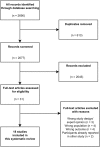Management of constipation in patients with Parkinson's disease
- PMID: 29560414
- PMCID: PMC5856748
- DOI: 10.1038/s41531-018-0042-8
Management of constipation in patients with Parkinson's disease
Abstract
A considerable body of research has recently emerged around nonmotor symptoms in Parkinson's disease (PD) and their substantial impact on patients' well-being. A prominent example is constipation which occurs in up to two thirds of all PD-patients thereby effecting psychological and social distress and consequently reducing quality of life. Despite the significant clinical relevance of constipation, unfortunately little knowledge exists on effective treatments. Therefore this systematic review aims at providing a synopsis on clinical effects and safety of available treatment options for constipation in PD. For this purpose, three electronic databases (MEDLINE, EMBASE, PsycINFO) were searched for experimental and quasi-experimental studies investigating the efficacy/effectiveness of interventions in the management of PD-associated constipation. Besides, adverse events were analyzed as secondary outcome. In total, 18 publications were identified involving 15 different interventions, of which none can be attributed sufficient evidence to derive strong recommendations. Nevertheless, some evidence indicates that dietetic interventions with probiotics and prebiotics may reduce symptom burden while providing a very favorable side-effects profile. Furthermore, the use of lubiprostone, macrogol and in the specific case of isolated or prominent outlet obstruction constipation injections of botulinum neurotoxin A into the puborectal muscles may as well be moderately supported. In summary, too little attention has been paid to treatment options for constipation in PD leaving abundant room for further research addressing this topic.
Conflict of interest statement
D.P. has received personal fees from the Boston Scientific Corporation. L.T. reports grants, personal fees, and non-financial support from Medtronic, Boston Scientific, Union Chimique Belge, Abbvie, Bayer, and Teva; personal fees and non-financial support from General Electric Medical, Desitin, and Archimedes Pharma; personal fees from Bial and Zambon. The remaining author declares no competing financial interests.
Similar articles
-
Management of constipation in Parkinson's disease.Expert Opin Pharmacother. 2015 Mar;16(4):547-57. doi: 10.1517/14656566.2015.997211. Epub 2014 Dec 25. Expert Opin Pharmacother. 2015. PMID: 25539892 Review.
-
Telephone interventions for symptom management in adults with cancer.Cochrane Database Syst Rev. 2020 Jun 2;6(6):CD007568. doi: 10.1002/14651858.CD007568.pub2. Cochrane Database Syst Rev. 2020. PMID: 32483832 Free PMC article.
-
Efficacy and safety of probiotics in Parkinson's constipation: A systematic review and meta-analysis.Front Pharmacol. 2023 Jan 10;13:1007654. doi: 10.3389/fphar.2022.1007654. eCollection 2022. Front Pharmacol. 2023. PMID: 36703760 Free PMC article.
-
The pharmacological management of constipation in patients with Parkinson's disease: a much-needed relief.Expert Opin Pharmacother. 2020 Apr;21(6):701-707. doi: 10.1080/14656566.2020.1726319. Epub 2020 Feb 8. Expert Opin Pharmacother. 2020. PMID: 32037901 Review.
-
Use of probiotics for the treatment of constipation in Parkinson's disease patients.Minerva Gastroenterol Dietol. 2011 Jun;57(2):117-21. Minerva Gastroenterol Dietol. 2011. PMID: 21587143 Clinical Trial.
Cited by
-
Convergent pathways of the gut microbiota-brain axis and neurodegenerative disorders.Gastroenterol Rep (Oxf). 2022 May 16;10:goac017. doi: 10.1093/gastro/goac017. eCollection 2022. Gastroenterol Rep (Oxf). 2022. PMID: 35582476 Free PMC article. Review.
-
Mediterranean Diet Adherence in People With Parkinson's Disease Reduces Constipation Symptoms and Changes Fecal Microbiota After a 5-Week Single-Arm Pilot Study.Front Neurol. 2021 Dec 23;12:794640. doi: 10.3389/fneur.2021.794640. eCollection 2021. Front Neurol. 2021. PMID: 35002935 Free PMC article.
-
Cold-pressed perilla seed oil: Investigating its protective influence on the gut-brain axis in mice with rotenone-induced Parkinson's disease.Food Sci Nutr. 2024 Jun 14;12(9):6259-6283. doi: 10.1002/fsn3.4265. eCollection 2024 Sep. Food Sci Nutr. 2024. PMID: 39554352 Free PMC article.
-
Redefining Non-Motor Symptoms in Parkinson's Disease.J Pers Med. 2025 Apr 26;15(5):172. doi: 10.3390/jpm15050172. J Pers Med. 2025. PMID: 40423044 Free PMC article. Review.
-
The human gut bacteria Christensenellaceae are widespread, heritable, and associated with health.BMC Biol. 2019 Oct 28;17(1):83. doi: 10.1186/s12915-019-0699-4. BMC Biol. 2019. PMID: 31660948 Free PMC article. Review.
References
Publication types
LinkOut - more resources
Full Text Sources
Other Literature Sources


